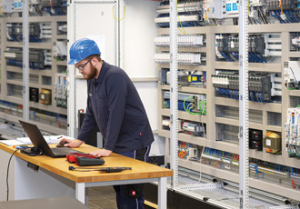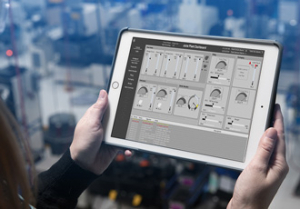A chip designed just for you will give your product the edge
Can a single, multi-function electronic component, designed and produced specifically for a single customer or product, make a major contribution to functionality, performance, size, reliability and overall cost? Without a doubt says Richard Mount of Swindon Silicon Systems. What’s more, incorporating Application Specific Integrated Circuits (ASICs) will make your offering unique while insuring against future component supply issues during the lifetime of the product, according to Mount.
Electronics technology, in all its forms, has moved into our lives at a rate no-one could have predicted as recently as ten years ago. It is hard to believe that it’s only that long since the launch of the first Apple iPhone! So, to ignore the benefits that today’s electronic components can bring to your product or application, is leaving the technology door wide open for your competition.
I should point out here that consumer electronics is not our business but I have used the readily identifiable smartphone as an example to illustrate how single components can have a major impact on a product’s design. The smartphone’s size, functionality and capability is due mainly to its use of the latest processing, memory and communications technology much of which is integrated within single, purpose designed devices.
ASICs suit many applications
It may not be obvious, but ASICs, or Application Specific Integrated Circuits, are now a constant feature in our lives. Without them, practically every product that uses electronics technology could not possibly exist in its present form.
For example, electronics is now a major part of the cost of a new car - even the mid-range models of 2017 incorporate many safety and comfort features which themselves make use of a surprisingly large number of ASICs. These are often mixed signal devices that combine the benefits of analogue and digital devices in a single chip. They can be found in every system from climate control to airbag deployment and from infotainment systems to one of our particular specialities, tyre pressure sensing where we are technology and market World leaders.
You will also find ASICs in the latest medical instruments, test and measurement products, hearing aids and many types of white goods. Continuous development in ASIC design as well as an increase in function and capability have driven more and more companies across many industry sectors to choose ASICs as a cost-effective alternative to traditional electronic circuitry. This is particularly evident in factory automation and industrial controls where integrated sensor interfaces and the latest wireless standards combine to offer designers a very capable single device.
In fact, ASICs are being widely used wherever capability, size, cost and, in many cases, resistance to “difficult” environments are key requirements. Also, there are some discrete or traditional component approaches that simply cannot provide the required level of performance, size and cost to be viable within its designated market and the ASIC approach is therefore fundamental to achieving project goals. Another significant benefit is the protection of a customer’s intellectual property along with improved product reliability as well as inventory reduction since these complete subsystems often replace a number of components.
Other significant ASIC advantages
With many existing applications, it can often be beneficial to replicate or even “reverse-engineer” an existing design and port it to an ASIC in order to introduce new functionality within a much smaller form factor while allowing backward compatibility. This approach can preserve a customer’s existing design investment while giving equipment a new and extended lease of life.
An ASIC comes into its own if an existing component supplier is making a process obsolete but there is still a potential long lifetime remaining for the end product. Here, it is possible to re-engineer a drop-in replacement to enable the continuation of the product’s availability.
There are also advantages from a customer’s engineering team perspective where the designers provide a specification that outlines functionality and input and output criteria and the ASIC supplier wholly designs the circuitry. The main advantage for this is that the customer’s engineering team is then free to concentrate on other core issues including production of the end product.
To summarize, here are some of the key benefits that an ASIC can bring:
1. Higher integration
2. Smaller footprint
3. Lower power consumption
4. Higher functionality
5. Intellectual Property protection
6. Ease of final manufacture
7. Obsolescence guarantee
8. Proven development and logistic routes
Going down the ASIC route
So how do you go about developing an ASIC produced specifically for your requirement?
It’s not always straightforward to understand which components can be replaced and which functions can be improved or, indeed, newly introduced to a product under design. The right ASIC can also go much further. Size reduction is a given and lower power consumption is yet another benefit and even the all-important cost advantage can be a great side effect.
Incorporating a device that is specified, designed and manufactured solely for you adds two more clear advantages. It gives your product a commercial and technical edge over your competitors and provides you with obsolescence assurances during the lifetime of your product that you could not have when using standard components.
The diagram above shows the range of functions that can be incorporated into your ASIC. As you can see, the device can contain all the processing and memory capacity required to control and manage the task while signal processing and sensor interfaces can deal with converting information from devices in the “outside world” into a format understood by the digital one. Add to this the chip’s ability to make decisions based on incoming status information and then communicate the necessary action while using a fraction of the power consumed by the components it replaces, makes an ASIC an obvious choice for a great many applications.
Choosing the right partner to help you understand and implement an ASIC solution is key to the project’s success, so here’s a few pointers.
Those new to the potential of ASICs may be persuaded that the most obvious solution is to use a single device manufacturer who will design and manufacture your chip. However, their manufacturing facility (called the fab for fabrication or foundry these days) may not be able to offer the right combination of process technologies and this can lead to design compromises. In other words, you might not get the best device for the application. Couple this with the fact that the manufacturer may decide to discontinue production if violent currency fluctuations make it unprofitable in the future.
The second option is to start with the foundry but they have no in-house design capability. They may well recommend a designer but that still leaves several further steps to take.
A major downside of this approach is that the team working to develop, make and test the ASIC can now be spread across three or more companies. Not the most ideal solution and often unnecessarily time consuming.
Experience (almost 40 years in our case) tells us that the first move should be the selection of the best design partner since all successful ASIC solutions are based on the intellectual cooperation between a customer’s design team and ours.
As a fabless ASIC design company, we are able to select the right manufacturing and packaging partner for your project which means we match the perfect process technology to the performance needs of the agreed design. Once the design is completed and the first devices produced, we have fully integrated production test, validation and assurance facilities available at a single site. So once the device is in full production, we are able to control the cost and flow of each step of the process.
The advantages of ASICs are real and they are ones that can add sales and profitability to most companies. The only choice the customer has to make is which partner can offer them the best product with the best performance at the lowest cost with the least risk.
It costs nothing to find out about the approach we take when discussing a new project. You will have a clear idea about the product you are developing and we will quickly show you how incorporating the latest ASIC technology will bring it to market more quickly with better performance and higher reliability and on budget.
More at www.swindonsilicon.com
Similar articles
More from SWINDON silicon systems
- A chip designed just for you will give your product the edge 4th November 2017




 technology at Jacobs Vehicle Systems.JPG)







Write a comment
No comments